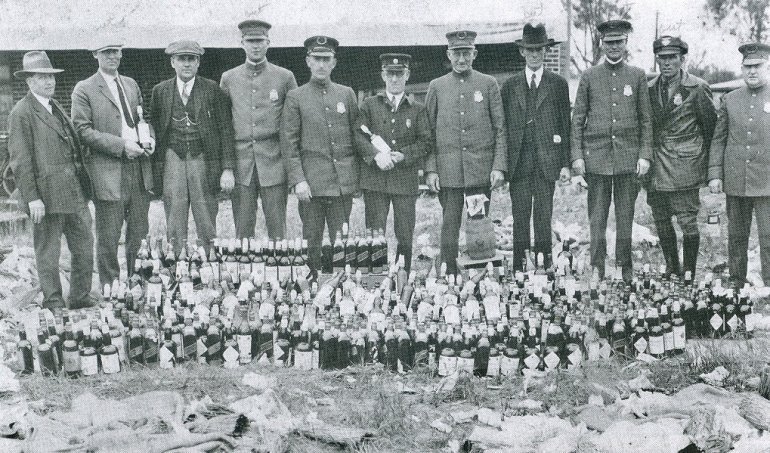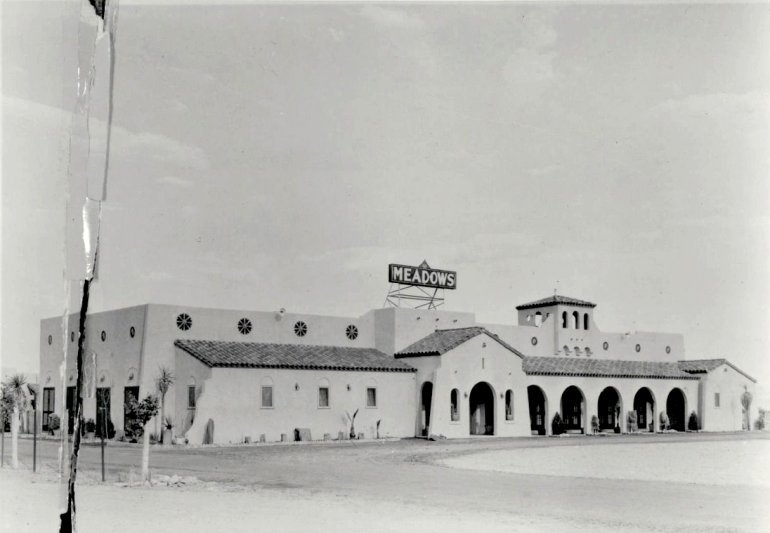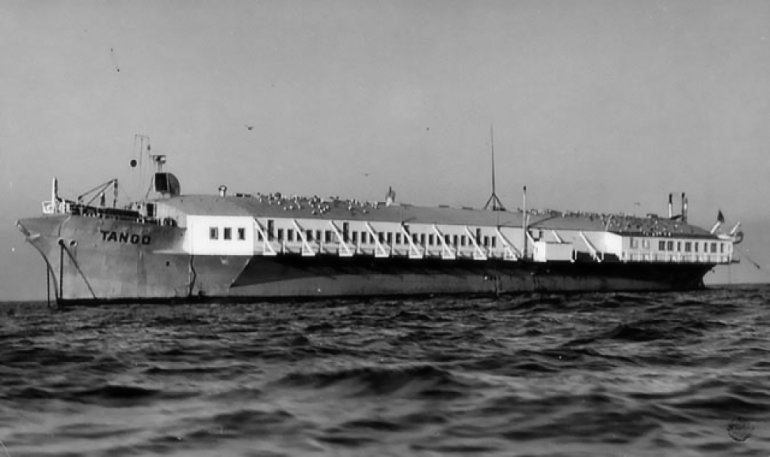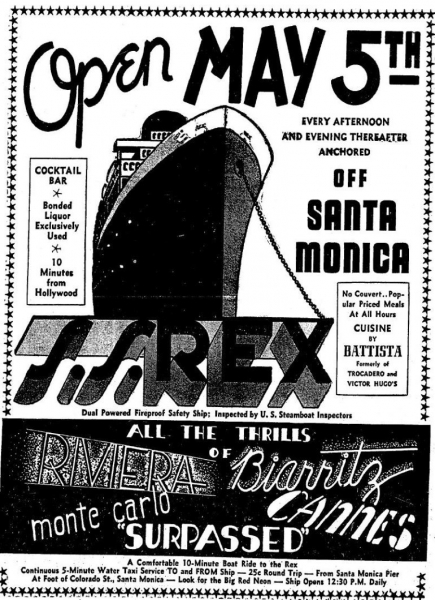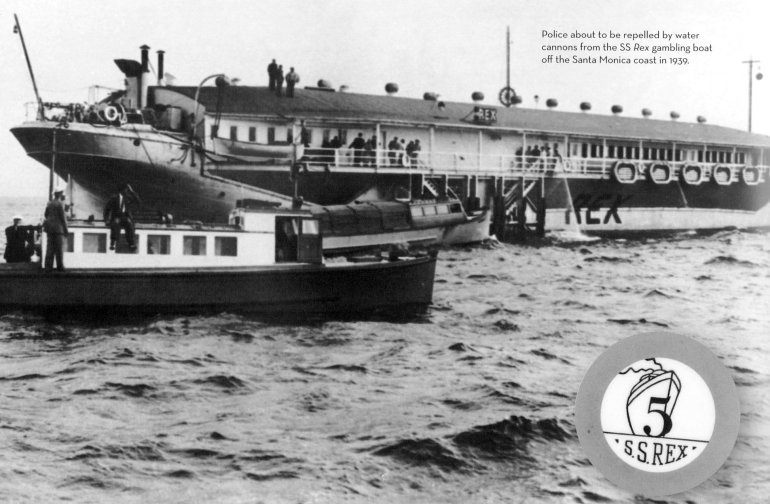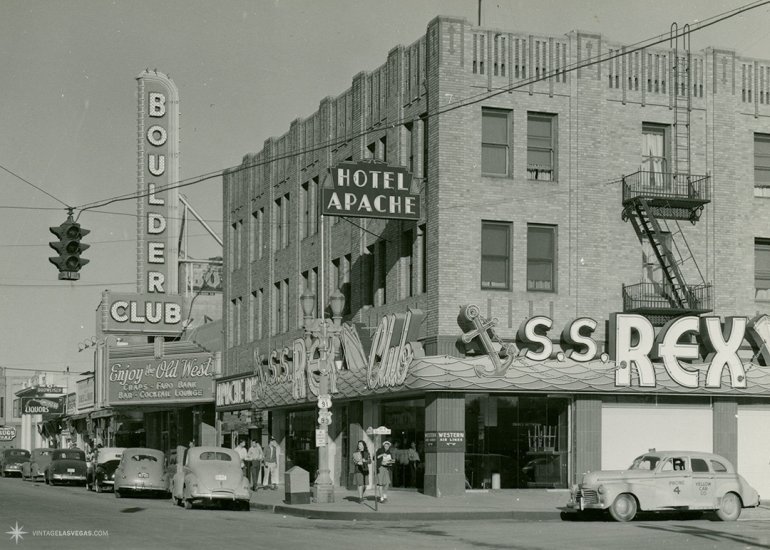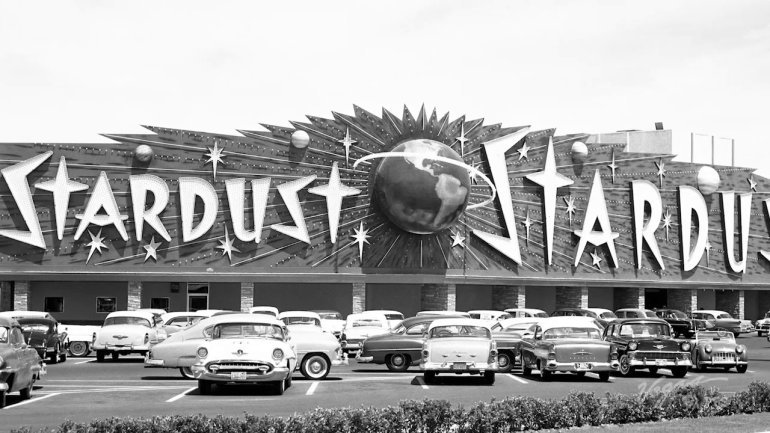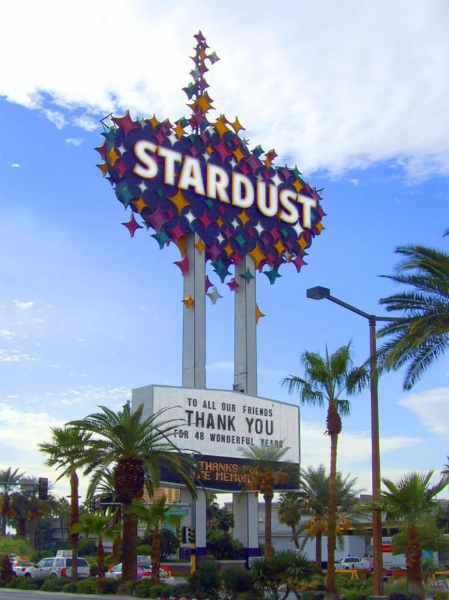The story of Anthony Cornero is one of the most impressive and incredible stories in the history of Las Vegas. Tony Cornero, also known as “The Admiral” and “Tony the Hat,” was a bootlegger and entrepreneur. Throughout his multifaceted career, he engaged in bootlegging, managed gambling ships in Los Angeles, and built casinos in Las Vegas.
Childhood and Youth
Anthony Cornero Stralla was born on August 18, 1899, in the small Italian town of Lercara Friddi. When Tony was five, his father lost their farm in a card game, and a fire destroyed their crops. The Cornero family was forced to immigrate to America, where Tony arrived with his parents, two sisters, and two brothers.
Tony’s father passed away a few years later, and his mother remarried Luigi Stralla. Tony became a cabin boy and signed a contract with a trading ship bound for the Far East.
The Rise of “The Admiral” Cornero
By the time he became “The Admiral,” Tony Cornero was already quite well-known. Even before turning thirty, he made a million dollars during Prohibition, smuggling Scottish whiskey into California from Vancouver and using the shrimp business as a cover. Tony transported the whiskey on his small fleet of cargo ships. One of Cornero’s ships, the SS Lily, could carry up to 4,000 cases of contraband spirits in a single voyage.
This lifelong activity instilled in him a love for the sea. In the predawn maneuvers off the coast, he would transfer the liquor from the cargo ships to small boats, which would deliver it to the beaches of Malibu. His fleet easily evaded the understaffed and ill-equipped U.S. Coast Guard. Due to his impeccable maneuvers on the water, he began to be called “The Admiral” Cornero.
In 1926, “The Admiral” was apprehended in San Pedro Bay with a thousand cases of whiskey on his yacht. When transported to jail, Tony jumped off the train, then hired as a sailor on a ship to Europe, where he remained hidden for two years. In 1929, he returned to Los Angeles and surrendered to tax inspectors.
Creating Meadows Supper Club
After serving two years and being released from prison on McNeil Island, Tony was unemployed due to the repeal of Prohibition. Reviewing a list of still illegal activities, Cornero chose to gamble. It was not as vile and degrading as prostitution and drug trafficking, and it was necessary to Tony, who had some moral principles.
With money from whiskey trading, Cornero set his sights on Las Vegas, where he is now considered a visionary and pioneer. Even before Nevada legalized gambling, Tony Cornero and his brother Frank organized the construction of Meadows. Just a few weeks after gambling was legalized, on May 2, 1931, the Las Vegas Age wrote:
Powerful in its functionality, mysterious in its charm, The Meadows Casino&Hotel, America’s most luxurious casino, will open its doors tonight.
And so it happened, and the first luxurious hotel-casino in Las Vegas called Meadows Supper Club opened its doors. It may seem obvious now that casinos should have carpets and hotel rooms with hot water, but at that time, casinos in Vegas had sawdust on the floor. Meadows sharply contrasted with the fashionable salons downtown. Meadows had its runway for adventurous wealthy seekers, 30 luxurious hotel rooms – each with its bathtub and hot water available 24 hours a day, just like electric lighting. It was a new attraction in Las Vegas. The Meadows Club acted as a magnet and attracted players in droves.
But Cornero couldn’t stay away from the sea for long. He presented Meadows as a pleasure club accessible to the American middle class – a precursor to today’s Vegas economy targeting middle-income players. However, he was ahead of his time: the casino was built on the barren soil of the Great Depression.
Moreover, Cornero’s success soon attracted unwanted attention. Charles “Lucky” Luciano, the boss of the New York criminal clan, and his associates demanded a percentage of Cornero’s gambling profits. Cornero refused the extortion, and Meadows was eventually set on fire. So, just two months after its opening, Cornero sold his share and returned to California.
Three-Mile Limit
Tony was drawn to the growing phenomenon of gambling ships. In those years, the situation was as follows:
Gambling was prohibited in California, but the state laws only applied within three miles of the coast. Maritime entrepreneurs built massive ships, converted them into casinos, anchored them just over three miles offshore, and declared themselves beyond the law.
Since 1926, the “Joanna Smith” had been operating, and in 1932, when the 1932 Summer Olympics attracted crowds of athletes and spectators, the Monte Carlo and La Playa joined it.
Floating Casinos
In February 1938, Cornero acquired two large ships. Investing $300,000, he refurbished them, equipped them with casino equipment, adorned them with chrome and neon, and renamed them SS Rex and SS Tango.
The two ships anchored beyond the three-mile limit of Santa Monica and Long Beach. They offered their customers:
- Roulette,
- Faro,
- Blackjack,
- Stud poker,
- High spade,
- Craps,
- Chuck-a-luck,
- Chinese lottery.
Tony installed 150 slot machines and set up a spacious horse salon and a 400-seat bingo hall. The flagship “SS Rex” could accommodate over 2,000 players simultaneously, along with a crew of 350 people, including waiters, chefs, a full orchestra, and a squad of marksmen. Wealthy individuals from Los Angeles would take water taxis to the ships to enjoy gambling, shows, and delicious food. One of the legendary visitors to the “Rex” was a mathematician and renowned gambler named Nicholas “Nick the Greek” Dandolos.
Cornero wanted his casino to appeal to the American middle class as well. Therefore, on May 5, 1938, advertisements appeared in local newspapers.
An advertisement offered people to experience “All the thrills of the Riviera, Biarritz, Monte Carlo, Cannes” for just twenty-five cents and a ten-minute boat ride.
He also hired pilots and instructed them to write “REX” in the California sky with letters two miles high.
And the ad worked. The main clientele of the “Rex” was not the famous and wealthy but ordinary people seeking to turn their small fortunes into a decent sum. They lined up by the thousands at the Santa Monica pier, waiting for Tony’s water taxis. Soon, the “SS Rex” was visited by three thousand people daily, earning $200,000 monthly.
The success of the floating casinos caused outrage among the authorities in California. According to Earl Warren, the Attorney General of California, Tony Cornero was riding the wave of criminality that threatened to engulf the state.
Those were tumultuous years. With the support of the Mafia from the East Coast, Bugsy Siegel organized crime in Los Angeles, and corruption in the city led to the recall of Mayor Frank Shaw – the first time a major American city had recalled its mayor.
During Prohibition, Tony Cornero was associated with prominent figures in the Mafia. It is said that Siegel invested in the “SS Rex.” Minor crimes were a common occurrence beyond the three-mile limit. In some cases, murderers sought refuge on gambling ships after committing crimes.
The Beginning of the Battle in Santa Monica
And so it came to pass on August 1, 1939 – the day Warren had planned in the utmost secrecy when he ordered a series of raids against his gambling ships.
Earl Warren watched the raid through binoculars. From the Santa Monica Beach Club, the Attorney General of California – and future Chief Justice of the United States Supreme Court – observed as the fleet he had assembled set sail into the bay. He only informed the two hundred and fifty officers, currently bouncing on the waves in flimsy boats, about their mission a few minutes before it began. After all, he had long dreamed of his triumph ever since the planes wrote those devilish letters in the sky: REX, and he didn’t want any chance event to disrupt his plans.
It seemed like it would be easy. The officers boarded the first ship, the “Texas,” whose crew immediately surrendered. Warren’s men took axes, began smashing the equipment, craps tables, and roulette wheels, and threw slot machines into the bay. Soon, news came that simultaneous raids on the ships “Tango” and “Showboat” off Long Beach had gone just as smoothly.
In the fleet of the gambling armada, only one flagship remained – the “Rex.” But Warren should have known it would be different with it. When the officers attempted to board the ship, a steel door slammed shut in front of the boarding ramp, and high-pressure fire hoses sprang into action from the upper decks, repelling the invaders.
Sound carries far over the water, so Warren heard a man’s cry from the shore: “I won’t surrender my ship!” It was Tony Cornero, the “commodore of the gambling fleet” and Warren’s curse. He had just initiated an eight-day standoff known as the Battle of Santa Monica Bay.
A Legal Conundrum
But whose side was the law indeed on? The adversaries found themselves in a strange legal impasse: it all depended on a cartographic question – where to draw the three-mile boundary? Naturally, Cornero anchored the “Rex” three miles off the coast. However, the district attorney argued that the shoreline should be drawn across the bay itself, between Point Dume and Point Vicente, and therefore, the “Rex” should sail further into the ocean, where strong currents and ocean waves could disrupt the functioning of the roulette wheel and cause players to experience seasickness.
Cunning Cornero objected, claiming that Santa Monica Bay was, in fact, a cove – merely an indentation on the coastline. Interestingly, the courts agreed with his version of the three-mile zone, and the “Rex” remained in its original location, now known as Santa Monica Bay.
Protracted War
On the first night of the battle in Santa Monica Bay, while firefighters were still holding back his men with their hoses, Warren negotiated a safe passage for the six hundred players still on board. But on the second day, the Attorney General failed to capture the ship. Cornero laughed at the officers bobbing in their tiny boats around his imposing Rex, calling them a “bunch of miserable pirates.” He treated the ever-present reporters to rum, and humiliating headlines appeared in the newspapers: “Flagship of the Gambling Fleet Still Holds After Winning with Water Sprays.”
“We have plenty of provisions, and we’re having a good time,” Cornero told reporters on the third day of the siege. “I have no immediate plans, and I’m unconcerned.”
Cornero always portrayed himself as a man of the people, and people believed him. For instance, Tony justified his alcohol smuggling activities by saying he didn’t want Americans to poison themselves with homemade liquor. He offered a $100,000 reward to anyone who could prove that there was cheating in the casino on the Rex. “Brave and honest American citizens run this ship,” he said.
On the other hand, Warren tried to create the image of a classic patrician. He began by declaring the raid a success. After all, gambling had ceased on the ship! “I don’t think they can commit any crimes if they don’t start stealing from each other,” he said. As for Admiral Cornero’s surrender, Warren promised that “the law will prevail, even if it takes a whole year.”
Warren attempted to achieve moral superiority. He referred to the ships as a public nuisance contributing to juvenile delinquency, forcing young people into an idle and debauched lifestyle. It is said that Warren developed a hatred for gambling in his youth when he witnessed families starving because men were engaged in gambling.
But to defeat Cornero, Warren had to play dirty. It was only in 1980 that it was revealed that Warren had ordered illegal wiretapping of Cornero’s phones.
It should be noted that, at the time, this was an extraordinary step, which he had even refused to take when investigating his father’s murder.
What’s worse, in an attempt to turn public opinion against Cornero, Warren told the press that the Admiral planned to raise the Japanese flag on the Rex, essentially accusing him of treason.
None of these tactics worked. Cornero denied any plans to hoist the Japanese flag. The siege continued. Journalists documented how Cornero spat in the direction of two police-packed boats. He was a fearless man. But time was on the side of the state. After eight long days of confrontation, the water ceased to flow from the hoses, and Cornero surrendered. With typical gangster bravado, he explained why he resigned: he said he needed a haircut, and a barber was the only thing he didn’t have on board.
The Rex as Symbols of Freedom
Gambling in the United States has always had libertarian undertones. Gambling can be seen as the metamorphosis of the most efficient capitalism of a free market. The prominent American economist Milton Friedman spoke about it as follows:
“Every day, we all engage in gambling. It is an economic system that has changed our society. Of course, not everyone enters the casino with the same bankroll, but gambling is a great equalizer. In cards, all people are equal.”
Thanks to this worldview, ships like the Rex soon entered the public consciousness as symbols of freedom, freely sailing just beyond the horizon of control. It seemed as if the original spirit of free America was still preserved three miles off the coast.
Meanwhile, the clouds of war gathered. Cornero eventually lost in court – the fateful shot came from the state Supreme Court, which ruled on November 20, 1939, that the waters off Santa Monica Bay fell under the jurisdiction of the state. Cornero was forced to close his floating casinos. The Rex was sold and later converted for cargo transport during World War II, which was a sad and somewhat ironic twist for the proud old ship. It was later torpedoed off the shores of one of the Latin American countries.
SS Rex in Las Vegas
So many failures and defeats should have put an end to Stralla, the Admiral of the gambling fleet, but it didn’t. He continued to fight. Tony Cornero attempted to open illegal land-based casinos in Los Angeles, but the local Mafia thwarted him.
In 1944, he went to Las Vegas, where he connected with his friend Orlando Sylvan, the owner of the Apache Hotel. Cornero leased a floor from him and opened a nostalgic maritime-themed casino called SS Rex. The Las Vegas City Council, aware of Cornero’s history with Green Meadows and his floating casinos, voted “against” initially. Still, later a board member changed his vote, the proposal was accepted, and Tony finally obtained a license.
While managing the land-based Rex, Tony longed for his flagship and the old days. In 1946, during a later vote, the Las Vegas City Council revoked Cornero’s gambling license, and the Japanese fleet was destroyed, making the Pacific Ocean safe again. Seeing such a familiar coincidence, Tony closed the SS Rex and decided to set sail once more.
The Commodore’s Return
Tony Cornero boldly returned to California, bought a military minesweeper, and rebuilt it in the image of the Rex. In addition to many tables, wheels, and slot machines, he added a spacious dance floor and a thirty-meter bar. The Commodore’s new flagship was named the SS Lux and proclaimed a “million-dollar gambling ship.” It dropped anchor six miles off Long Beach.
On August 7, 1946, at 5 p.m., Tony Cornero reopened the casino, which attracted 3,600 customers in the first three hours of operation. The comeback was complete.
During this time, Earl Warren had become the Governor of California – it was rumored that he obtained the position by getting rid of the gambling ships. And then came the news! Warren was shocked to hear about the SS Lux. “Cornero has challenged me!” he raged. “No one in the country is cool enough for this!” And so, the doomed war began once again.
Initially, the authorities cut off his water taxi service, ignoring the angry cries of visitors waiting on the Long Beach pier. On August 9, after three days of operation and a good bribe of $175,000, Cornero was arrested on six counts of gambling and conspiracy. After being released from jail on a large bail, Tony declared his arrest unlawful. He claimed that his ship was sailing in “international waters,” not American waters, and his water taxis were engaged in “foreign trade.”
The state authorities were unimpressed by Tony’s claims and arrested the Lux for operating without a license as a “coastwise trading vessel” since the ship lacked its engine. This legal charade continued until April 28, 1948, when President Truman signed an act prohibiting the use of any gambling ships in U.S. territorial waters.
Thus, the maritime career of Antonio Stralla, the “Commodore of the Gambling Fleet,” was finally ended. His rival, Earl Warren, reluctantly admitted that Tony:
- never cheated in his casinos,
- was never associated with the Mafia,
- and never backed down from his word.
Unfortunately, honesty, steadfastness, and independence do not always guarantee success in a free enterprise system.
Assassination Attempt
After the failures with the maritime casinos, Tony planned to invest in Lower California. On February 9, 1948, Tony Cornero met with two Mexican businessmen. There was a knock on the door, and Tony heard someone behind the entrance say, “Package for you.” Tony opened the door, and two men entered the house. An argument ensued, followed by a gunshot through the box one of the men carried. Tony grabbed his stomach and shouted to his wife, “Grab my gun, quickly!”
Tony fell to the ground, and the two assailants began searching his pockets before quickly fleeing. Tony was rushed to the Cedars of Lebanon Hospital, where doctors worked feverishly to save his life. It was believed that the bullet had pierced his liver. Luck was on Tony’s side, and he survived to tell the tale, but not the motive. He evaded giving statements to the police, providing an indistinct description of the attacker as “tall, thin, with a thin face resembling Humphrey Bogart.”
The police put forth two versions while searching for a motive and suspect. Here’s what they came up with:
- Tony failed to share the money he earned from his “Lux” gambling barge with the “investors.”
- Tony attempted to organize a revival of gambling in Lower California. Even Mexican newspapers printed headlines such as, “Gambling will be allowed in Lower California if Cornero is eliminated.”
What happened remains unknown. Tony remained silent. It seemed that after all these twists and turns, Tony Cornero would finally settle down and step away from his affairs. But no, that wouldn’t be in the Commodore’s style. He recovered and decided it was time to return to his old connections in Las Vegas. The Admiral couldn’t sit still and embarked on one last journey that would leave its mark on the history of gambling.
Stardust Casino
When Tony arrived in Las Vegas, he purchased a 40-acre plot on the Las Vegas Strip and began construction on the Stardust Casino, which became his swan song. Cornero’s strategy was to move away from the elegance of the Desert Inn. He wanted to attract mass visitors, not just seasoned players and high rollers, who were the primary audience in casinos then.
In 1954, Cornero founded the Stardust Company. Hundreds of shares were sold. The new casino resort was supposed to be called “Tony Cornero’s Starlight” and have its train station on the Union Pacific railroad line, but the railroad station never materialized.
Cornero’s idea was to establish a new standard of living in casino resorts, and his motto was “Astronomical luxury at reasonable prices.” The hotel was meant to offer a unique quality of accommodation. It was designed to host large conferences and cater to a broad audience seeking entertainment and pleasure.
All rooms were to be equipped with air conditioning, and the hotel was set to have the most prominent theater restaurant on the Strip. Tony also envisioned shops and various establishments on his resort grounds dedicated to the entertainment and relaxation of the public. Note that this was 1954, and no one knew what casino resorts should look like. Thus, Tony Cornero created the rules and prototypes and played a significant role in shaping the current appearance of Las Vegas casino resorts.
Stardust was nearly completed, but Cornero never saw his dream become a reality. Fate intervened, and on July 31, 1955, Cornero went to the Desert Inn casino to play a game of craps. At one of the gaming tables, at 11:17, Cornero suffered a massive heart attack and almost immediately passed away.
Rumors circulated that someone had poisoned Cornero’s drink. Perhaps these rumors weren’t unfounded because:
- Cornero’s body was taken to the morgue before anyone called the police.
- The drinking glass used by Cornero was washed.
- An autopsy was not performed.
Despite all these glaring facts, a Los Angeles grand jury ruled that Tony Cornero died of a heart attack.
The next day, all Las Vegas newspapers featured articles about his life and death on their front pages. Journalist Bob Holford of the Review-Journal best described the circumstances of his death:
“Tony died as he lived.
He died at the gambling table.
Probably, the gambler was damn lucky when he felt the overwhelming heat crash onto his chest, obliterating the entire world.
What other way was there for him to go? In bed? Never!
In a shootout? They tried that too!
In an ambush? They tried that as well!
Tony went the way any hardened gambler wants to go. Fast and painless! The pain that struck Tony Cornero Stralla lasted less than 10 seconds, and it was all over.
He went bust.”
On July 2, 1958, Cornero’s dream became a reality as the Stardust Resort and Casino opened, becoming the largest hotel in the world. Stardust enjoyed tremendous success until an explosion demolished it.
Epilogue
By the time of Cornero’s death, Earl Warren was already serving as the Chief Justice of the United States Supreme Court. He had become one of the most famous figures in the country and even considered running for the presidency. The Battle of Santa Monica Bay became a mere footnote in his biography. However, when he heard about Tony Cornero’s death, the Chief Justice raised a toast to his old sworn enemy, the Admiral of the Gambling Armada, and said:
“The crooks have changed. They no longer have that audacity.”
Часто задаваемые вопросы
🎲 Which was the first casino built by Tony Cornero, and when was it opened?
Even before Nevada legalized gambling, Tony Cornero and his brother Frank organized the construction of The Meadows Casino & Hotel, which opened on May 2, 1931.
🚣 Why was the “three-mile limit” called the “Puritan Condom”?
Gambling was prohibited in California, but the state laws only applied within three miles of the coast. Beyond that, floating casinos operated legally. Thus, people could “pierce” the prohibition by taking a trip to the ships via water taxis.
❓ How many floating casinos did Tony Cornero have in total?
There were a total of four. Three of them – Rex, Tango, Showboat, and Texas – were closed in 1939. Another one – Lux – closed in 1948.
🔫 When was the assassination attempt on Tony Cornero?
The assassination attempt occurred on February 9, 1948, during a meeting between Tony Cornero and two Mexican businessmen.
🔥 How many years did the Stardust Casino operate before it was demolished?
Stardust Resort and Casino opened on July 2, 1958, and closed on November 1, 2006. Therefore, it operated for a total of 48 years.
